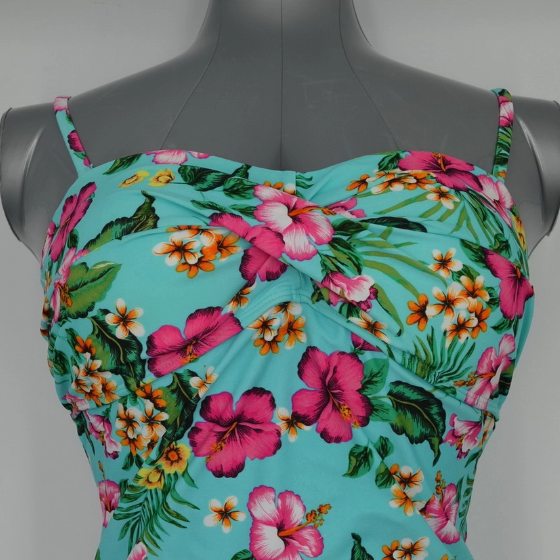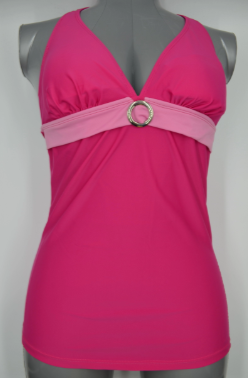
The fabric selection in ladies swimwear plays a pivotal role in determining both the comfort and longevity of the garment. With the ever-evolving textile technology, understanding the key fabric choices becomes imperative for consumers seeking durability without compromising on comfort. This comprehensive analysis delves into the various fabrics utilized in the swimwear industry, shedding light on their properties, benefits, and suitability for different swimming activities. Whether it's lounging by the pool or engaging in competitive swimming, the right Ladies Swimwear fabric can make a significant difference.
The Importance of Fabric Choice in Swimwear
Fabric choice is not merely a matter of aesthetics; it directly affects the swimwear's performance, durability, and comfort. The ideal fabric should resist fading, stretching, and degradation from chlorine, saltwater, and UV exposure. Moreover, it should provide the right amount of elasticity to ensure a snug yet comfortable fit. The growing consumer demand for sustainable and high-performance swimwear has prompted manufacturers to explore innovative fabric options, balancing functionality with environmental considerations.
Common Fabrics Used in Ladies Swimwear
Nylon (Polyamide) and Elastane (Spandex) Blends
Nylon blends are a staple in swimwear fabrication due to their exceptional strength and elasticity. The combination of nylon and elastane provides a smooth fit that conforms to the body's contours. Nylon is renowned for its quick-drying properties and resistance to abrasion, making it suitable for both recreational and athletic swimwear. However, prolonged exposure to chlorine can degrade nylon fibers over time, so it's essential for users to rinse their swimwear after each use to prolong its lifespan.
Polyester and Elastane Blends
Polyester blends have gained popularity for their superior chlorine resistance compared to nylon. Polyester fibers maintain their shape and color vibrancy even after repeated exposure to chlorinated water and sunlight. This makes polyester an excellent choice for swimwear intended for frequent use, such as in training or competitive swimming. The incorporation of elastane ensures the fabric retains the necessary stretch and comfort.
PBT (Polybutylene Terephthalate) Blends
PBT is a type of polyester that offers enhanced stretch and recovery, making it a preferred fabric in performance swimwear. Its natural stretch properties eliminate the need for high percentages of elastane, which can deteriorate faster. PBT fabrics are highly resistant to chlorine and have excellent shape retention, ensuring the swimwear maintains its fit over time. Additionally, PBT dries quickly and feels soft against the skin, contributing to overall comfort.
Neoprene
Neoprene is a synthetic rubber commonly used in wetsuits and specialized swimwear. It provides thermal insulation, buoyancy, and significant durability. Neoprene swimwear is ideal for cooler water temperatures and activities like surfing or open-water swimming. Its thicker composition offers extra protection but may restrict movement slightly due to reduced flexibility compared to traditional swimwear fabrics.
Chlorine-Resistant Fabrics
Chlorine-resistant fabrics are engineered to withstand the harsh effects of chlorine and other pool chemicals. These fabrics often combine polyester with PBT or are treated with special finishes to enhance resistance. They are ideal for swimmers who spend extensive periods in chlorinated pools, as they maintain color and elasticity for longer periods. Chlorine-resistant swimwear is a practical choice for swim instructors, lifeguards, and competitive swimmers.

Factors Affecting Durability and Comfort
Chlorine and UV Resistance
Chlorine and UV radiation are the primary culprits in swimwear degradation. Fabrics that resist these elements extend the garment's life and maintain appearance. Polyester and PBT fabrics exhibit high resistance, making them suitable for regular pool use. Additionally, UV-resistant fabrics protect both the swimwear and the wearer's skin by blocking harmful ultraviolet rays.
Elasticity and Fit
A fabric's elasticity determines how well the swimwear conforms to the body and retains its shape. Elastane is crucial for providing stretch, but excessive amounts can reduce durability. Balancing elastane content ensures optimal fit without sacrificing longevity. A well-fitted swimwear reduces drag during swimming and enhances comfort during movement.
Breathability and Comfort
Breathable fabrics allow for air circulation, reducing moisture buildup and enhancing comfort. Lightweight materials like nylon and certain polyester blends excel in breathability. This feature is particularly important in hot climates or during prolonged sun exposure. Comfortable swimwear encourages longer wear times and increases overall satisfaction with the garment.
Abrasion Resistance
Swimwear fabrics must withstand friction from movement and contact with surfaces like pool edges and lounge chairs. Fabrics with high abrasion resistance, such as nylon and certain polyester weaves, maintain their integrity and appearance over time. This durability is essential for swimwear longevity, ensuring the garment remains functional and visually appealing.
Innovations in Sustainable Swimwear Fabrics
The fashion industry's shift toward sustainability has influenced swimwear fabric development. Recycled materials like Econyl®, made from regenerated nylon, offer eco-friendly alternatives without compromising performance. These fabrics repurpose waste materials, such as discarded fishing nets and fabric scraps, into high-quality swimwear fibers. Sustainable fabrics often feature the same durability and comfort as traditional materials, appealing to environmentally conscious consumers seeking Ladies Swimwear that aligns with their values.
Comparative Analysis of Swimwear Fabrics
Understanding the strengths and limitations of each fabric helps consumers make informed decisions. Nylon blends offer excellent fit and comfort but may lack long-term chlorine resistance. Polyester blends provide superior durability and chlorine resistance but might feel less soft against the skin. PBT blends strike a balance, offering both comfort and resilience, making them suitable for competitive swimwear. Neoprene serves specific needs, providing insulation and protection in specialized conditions. Sustainable fabrics introduce environmental benefits, catering to the growing demand for responsible fashion choices.
Practical Considerations for Fabric Selection
Intended Use and Activity Level
The choice of swimwear fabric should align with the intended use. For occasional beachwear, comfort and style may take precedence, making nylon blends appropriate. For regular pool swimmers or those engaged in water sports, chlorine-resistant fabrics like polyester blends are advisable. Understanding one's activity level ensures the swimwear performs satisfactorily under specific conditions.
Care and Maintenance
Proper care extends the life of swimwear regardless of fabric. Rinsing swimwear after each use removes chlorine, salt, and sunscreen residues that can degrade the material. Hand washing with mild detergents and avoiding machine drying prevents unnecessary stress on the fibers. Manufacturers often provide specific care instructions tailored to the fabric composition.
Fit and Design Preferences
Fabric properties affect how swimwear fits and feels. Stretchier fabrics offer more flexibility in fit, accommodating various body shapes. The thickness and texture of the fabric also influence the garment's appearance and support level. Consumers should consider their comfort preferences and seek fabrics that complement the desired swimwear design.
Conclusion
Selecting the appropriate fabric for ladies swimwear is a nuanced decision that balances durability, comfort, and personal preferences. By understanding the characteristics of each fabric type, consumers can choose swimwear that not only meets their aesthetic desires but also stands the test of time. Whether opting for the softness of nylon blends, the resilience of polyester, or the sustainability of recycled fabrics, the right choice enhances the swimwear experience. Embracing informed decisions leads to greater satisfaction and value, ensuring that every swim is enjoyed to the fullest in quality Ladies Swimwear.





